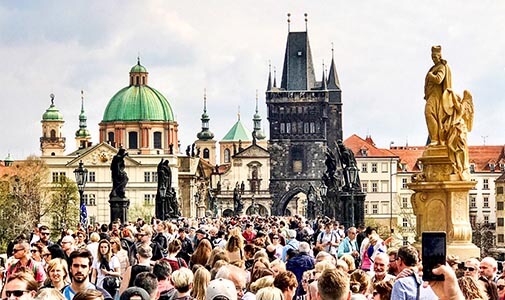It was 10 a.m. in Prague and I’d nearly finished my run, crossing the Svatopluk Cech Bridge toward the Jewish Quarter. I’d attempted to avoid the tourists I’d seen amassing on the nearby Legion Bridge I had crossed earlier. Yet, once over the river, I rounded a corner, finding myself on a narrow, packed street in Prague’s magnificent Old Town. But I could no longer see Prague’s exquisite cultural and architectural details. In fact, I couldn’t run anymore, as a sea of selfie-stick-snapping, elbow-jabbing tourists transported me into chaos. Obviously, this wasn’t my favorite experience in Prague.
Though some may accept the fate of traveling to Europe among mobs, my husband, Lynn, and I, U.S. expats living with our family in Switzerland, aren’t crowd people. So we’ve become travel sleuths, searching for alternative routes within our general destinations. We’ve come up with some methods to avoid crowds while exploring Europe:
Run, Bike, or Scooter
Though I was caught in the rush of Prague late on the morning mentioned above, I’d already run down cobbled streets through much of its popular neighborhoods, viewing ornate architecture, royal guards, castles, and cathedrals without many people present. In the Italian Alps, I once jogged up a trail in early morning through an entire Buddhist village—an Italian dharma association maintains a village and retreat center in the mountains—without seeing another human.
In France, I ran through Chamonix in an evening, finding quiet alleyways with tourist-free cafés and pretty viewing points to later show my family. We’ve also used an online app to rent scooters and zoom around tourists and along paths in Berlin, Vienna, and other cities. E-bikes are available in most European destinations, with well-marked, safe paths for biking virtually everywhere.
Wake Early for Major Sights
Sometimes we skip the interior of the most popular attractions altogether if the crowds are too immense. But we’ve found that many vacationers sleep in the morning and retire early in the evening. So, if we pack snacks and book the “Skip the Line” tickets (in advance whenever possible) to popular attractions like Italy’s Leaning Tower of Pisa or the Fernsehturm in Berlin;,we book the earliest morning time or the latest of the day. At these hours the light is also at its most dramatic for photographs, which is an added bonus.
If Possible, Head Upward
When we visited Prague’s Old Town Hall, there was a sea of people wading under its much-loved astronomical clock. But in the morning when we climbed up a long, wheelchair-friendly ramp to the tower top, we saw fewer people. It was the same with the tower at St. Vitus Cathedral at the upper reaches of the city. Many tourists remained at the base, photographing the view, not venturing up the final climb.
In Budapest, visitors took buses to the ridge of the Citadel and Parliament while we avoided the crowds by meandering to the famous destination up a quiet paved trail, admiring gardens and statues. Later, walking down rewarded us romantic quiet views of evening city lights.
Now, when visiting small villages in Northern Italy, Southern France, and Germany, we often seek steep roads, narrow staircases, and upward climbing paths. They may repel tourists, but climbing slows our pace, providing us with fabulous views and photo-worthy experiences.
Book Apartments or Boutique Hotels
Find places down quiet residential side streets.
When we travel in Europe, we use the 3D walk-through option in Google Maps to preview neighborhoods of potential rental apartments. We find the areas where most tourists stay (think big chains) but then deliberately seek flats or hotels nearby. The trick is to find places down quiet residential side streets.
Alternatively, we book flats in quaint neighborhoods outside the city or village center, like in Vienna when we stayed in a neighborhood called Gersthof with old homes, peaceful cafés, and easy, clean tram rides to the city. In Berlin we stayed in a neighborhood called Prenclauerberg in a rooftop apartment near artsy boutiques, quaint restaurants, and a sprawling park. We took trams to Checkpoint Charlie, rode a riverboat through Berlin’s center, and then escaped back to our sweet neighborhood to experience how Berliners truly live.
Stay in Lesser-Known Areas of Europe
Much of Europe hasn’t been well-covered or reviewed by travel apps but has plenty to offer and can be previewed virtually on Google. We’ve visited countless unadvertised villages, farms, and B&Bs in Europe where there aren’t many tourists but plenty of churches, shops, museums, restaurants, art, and nature to enjoy. Often the joy of a trip comes with the act of seeking.
MORE ONLINE: You may be interested to know that living in Europe is more affordable than you think. We’ve listed our top five European destinations here: IntLiving.com/Eurotop5.

